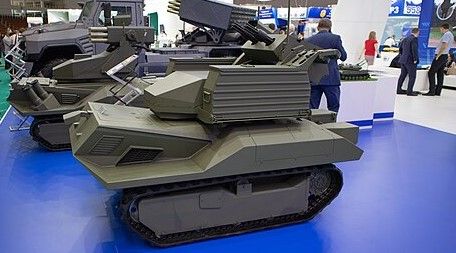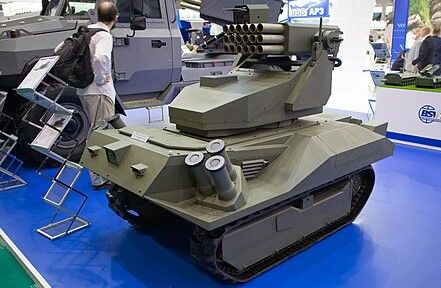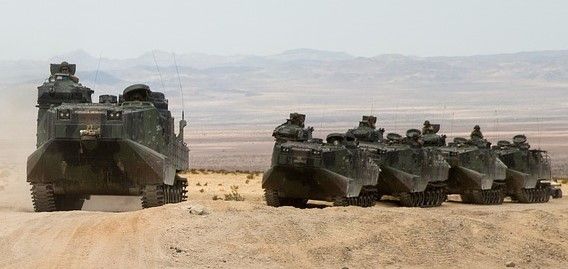Land Drones: Their Progress Towards the Battlefield
With aerial drones being so popular and effective, where are all the land drones?

Land drones, also known as uncrewed ground vehicles (UGVs), are the obvious next stage following the huge impact that uncrewed aerial vehicles (UAVs) are having in the Russia/Ukraine war. But how far has land drone design come and what role will they play in military operations?
As militaries continue to evaluate their needs and how they want to use UGVs in conjunction with older systems, the development of land drones will take a long to perfect. Airborne drones took a couple of decades to progress from prototype to combat, with its role on the battlefield still evolving.
In the same way, no one is certain if land drones will be used for reconnaissance, logistics, mine laying/sweeping, infantry support, or tank busting. Will they be operator controlled or run autonomously? Will they work individually, in small units, or in swarms?

As a recent report in the industry journal Defense News makes clear, “The development of UGVs has been a slow process and will likely take more time to refine, as militaries continue to assess their requirements and how they plan to field them in conjunction with legacy systems.”
Despite or because of all these unknowns, there is still a lot of interest in land drone technology.
“It is definitely a field that is taking off,” says Markus Otsus, a land drone project coordinator at the Estonian Military Academy.
For this reason, the industry is filled with respected manufacturers such as Rheinmetall and Milrem, whose respective platforms Mission Master and TheMIS have already been sold to over a dozen countries. As well as smaller start-ups, like the German-based ARX Landsystems who operate the Gereon RCS vehicle which is still in its early stages of development.
Land Drone Challenges
One of the biggest issues putting the development of land drones behind their airborne counterparts is terrain. Finding a technology which allows a land drone to ‘see’ the world around it and acknowledge its place in it – so-called perception and localization – has so far proved problematic.
As military analyst Elisabeth Gosselin-Maloexplains “Most vehicles are currently equipped with light detection and ranging (LIDAR) sensors, which provide long-distance vision during the day and night to identify and avoid objects. This is achieved by generating millions of data-points using laser beams, creating a live-3D map of its surroundings.”

The problem is detecting objects in poor weather, such as rain, fog, or snow. Dust and dense vegetation can also cause issues, while “laser-spoofing techniques can disrupt its perceptive abilities.”
This can leave land drones confused by high grasses or shrubs as they are unable to map their surroundings. In this situation, an operator is required to guide a land drone through rough or confusing terrain.
Unlike Teslas or other self-driving technologies, UGVs must be able to drive on more than just open roads.
Another danger of LIDAR in military applications is that it produces pulsed light waves into the environment as an active laser sensor; something which the enemy can easily detect with just a pair of goggles.
The importance of remaining quiet and unseen is obvious. Flashing a sensor every few seconds, is akin to having an infantry platoon waving torches about at night.
“Yes we do worry about it — which is why for the last year we have been trialing a few different passive sensing solutions that we hope to integrate into the next product release cycle,” says Luc Brunet, vice president of Rheinmetall Provectus.

Many land drone designs have also had problems maintaining secure and constant communications - a key requirement in the heat of battle.
“If you’re in the middle of an operation and urgently need situational awareness but the UGV loses connection or sends an error signal back, then the use-cases in which they can be operated are limited,” notes Otsus.
Given that autonomous driving can be fooled by something as common as driving through a forest, then as far as is known, the land drones being used in Ukraine are human-operated.
They vary greatly in size and capability. The smaller ones are designed to carry and place an anti-tank mine, others are used to transport artillery shells to forward guns. More advanced machines can actually work as combat weapons and carry remotely operated machine guns up to 10 km away from their handler. The latest designs are much larger, with testing now being conducted on land drones that may be able to carry and operate a gun as heavy as a 20mm cannon.

A gun of this size would be indispensable in breaking down well-defended positions or trench works. Especially as a UGV is far more expendable in approaching a network of anti-infantry and anti-tank mines. According to a recent Reuters report, the cheapest land drones in operation at the front can be deployed for as little as $800.
“It’s this type of battlefield innovation at the tactical edge in Ukraine that's going to (bring about) eventual emerging solutions that can lend themselves to long-term survival in combat.” explains Samuel Bendett, a senior fellow at the Center for a New American Security.
However, maintenance of these forward operating land drones is still an issue. Mud, dust, and break downs are a constant issue and a situation which is not helped by a limited supply of spare parts. The Reuters reporting noting that, “… components such as caterpillar tracks now retailing at inflated prices due to a global demand spike caused by the war.” Even simply electronics such as a transmitter which would cost around $50 before the war, can now only be bought for more than $300.

Despite this, research in Ukraine continues, with the Ukrainian government keen to support a lot of smaller start-ups, each using innovative approaches and advanced designs. Work is even progressing on getting self-driving land drones which use AI and machine learning into combat situations.
Away from the frontline, Western military researchers are testing their own land drone designs. The British for example, demonstrated a prototype UGV which weighed over five tons as recently as April. While in May, the U.S., British, and Australian militaries conducted, what Defense News describes as, “… an artificial intelligence and autonomy exercise involving drones, tanks and the Viking UGV, produced by Iveco-owned subsidiary Horiba Mira.”
Other nations are also designing their own medium-sized land drones, such as the Czech Taros land drone and the Spanish SR-0001.

However, as Otsus highlights, all of these designs lack real, operational testing and possibly durability. “In a situation like we’re seeing in Ukraine,” he says, “they need a lot more robustness in terms of being able to take a beating, not many systems have actually been out in the wild for months on end.”
Yet, alongside overcoming design and practical issues, no one is quite certain how land drones are best deployed.
“UGVs have thus far made important advancements primarily in non-kinetic tasks,” says Ivo Peets, chief of the Estonian Defense Forces’ long-term planning staff. “Such as mine-clearing, explosive ordnance disposal and evacuation.”
The path towards a complete integration of UGVs into national fighting forces is still unclear. Logistics? Reconnaissance? Combat? Maybe technology or experiences in Ukraine will decide.
Either way, most experts on the issue believe that autonomous land drones won't be fully functional until around 2040. This is in part due to the time that troops on the ground need to gain the practical knowledge in using and maintaining these technologies. Getting them to work as an integrated part of an armed force, in the same way that aerial drones are being used in Ukraine today.
As Bennet concludes, “The ultimate goal is to have these systems function autonomously in battle ... with human operators, UAVs, aerial and manned assets in a networked environment, … but we are far from that.”
To learn more about drone development, read: How Microdrone Use is Growing at the Frontline in Ukraine or Are Cheap Drones the Best Defence for Future Conflicts?
Photo credit: Gencraft, Sufyan on Unsplash, Myko M, ojosujono96 on Freepik, Military Material, Wikimedia, & Wikimedia

